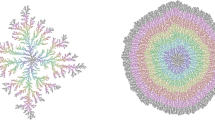Abstract.
In this paper we investigate the stochastic modelling of a spatially structured biological population subject to social interaction. The biological motivation comes from the analysis of field experiments on a species of ants which exhibits a clear tendency to aggregate, still avoiding overcrowding. The model we propose here provides an explanation of this experimental behavior in terms of “long-ranged” aggregation and “short-ranged” repulsion mechanisms among individuals, in addition to an individual random dispersal described by a Brownian motion. Further, based on a “law of large numbers”, we discuss the convergence, for large N, of a system of stochastic differential equations describing the evolution of N individuals (Lagrangian approach) to a deterministic integro-differential equation describing the evolution of the mean-field spatial density of the population (Eulerian approach).
Similar content being viewed by others
References
Billingsley, P.: Convergence of Probability Measures, (Wiley series in probability and mathematical statistics. Tracts on probability and statistics). New York: John Wiley & Sons, 1968
Boi, S., Capasso V.: Il comportamento aggregativo della specie Polyergus rufuscenslatr.: dalle osservazioni al modello matematico, Internal Report, Dipartimento di Matematica, Università di Milano, 1997
Boi, S., Capasso, V., Morale, D.: Modeling the aggregative behavior of ants of the species. Polyergus rufescens, Nonlinear Analysis: Real World Applications, I, 2000, pp. 163–176
Carillo, J.: Entropy solutions for nonlinear degenerate problems. Arch. Rat. Mech. Anal. 147, 269–361 (1999)
Diekmann, O., Gyllenberg, M., Thieme, H.R.: Lack of uniqueness in transport equations with a nonlocal nonlinearity. Math. Models Meth. Appl. Sci. 10, 581–592 (2000)
Durrett, R., Levin, S.A.: The importance of being discrete (and spatial). Theor. Pop. Biol. 46, 363–394 (1994)
Evans, L.C.: Partial Differential Equations. AMS, Providence, 1998
Ethier, S.N., Kurtz, T.G.: Markov Processes: Characterization and Convergence. Wiley, New York, London, Sidney, Toronto, 1986
Forel, A.: Les Fourmis de la Suisse. 2nd edition Imprimerie Coopèrative, La Chaux-de-Fonds, 1920
Forel, A.: Le monde social des fourmis du globe. 5 Libraire Kundig, Geneve, 1923
Friedman, A.: Stochastic Differential Equations and Application. Vols. I and II, Academic Press, London, 1975
Gärtner, J.: On the McKean-Vlasov limit for interacting particles. Math. Nachr. 139, 197–248 (1988)
Grünbaum, D.: Translating stochastic density-dependent individual behaviour with sensory constraints to an Eulerian model of animal swarming. J. Math. Biology 33, 139–161 (1994)
Grünbaum, D., Okubo, A.: Modelling social animal aggregations. In: Frontiers of Theoretical Biology, S. Levin, (ed.), Lectures Notes in Biomathematics, 100, Springer Verlag, New York, 1994, pp. 296–325
Gueron, S., Levin, S.A.: The dynamics of group formation. 128, 243–264 (1995)
Gueron, S., Levin, S.A., Rubenstein, D.I.: The dynamics of herds: from individuals to aggregations. J. Theor. Biol. 182, 85–98 (1996)
Harman, J.R.: Some aspects of the ecology of the slave making ant, Polyergus lucidus. Entomol. News 79, 217–223 (1968)
Huth, A., Wissel, C.: The movement of fish schools: a simulation model. In: Biological motion, W. Alt, G. Hoffman, (eds.), Lectures Notes Biomath., Vol. 89, Berlin, Heidelberg, New York Springer, 1990, pp. 577–590
Ladyzenskaja, O.A., Solonnikov, V.A., Uralceva N.N.: Linear and Quasilinear Equations of Parabolic Type. Translation of Mathematical Monographs, Volume 23, AMS, Providence, 1968
Levin, S.A.: Conceptual and methodological isuues in the modeling of biological aggregation. In: A Consensus of Individuals: The study of 3D Animal Aggregation, J.K. Parrish, W.M. Hamner, C.T. Prewitt, (eds), 1995
Mogilner, A., Edelstein-Keshet, L.: A non-local model for a swarm. J. Math. Bio. 38(6), 534–549 (1999)
Morale, D., Capasso, V., Oelschläger, K.: A rigorous derivation of a nonlinear integro-differential equation from a SDE for an aggregation model. Preprint 98-38 (SFB 359) - Reaktive Strömungen, Diffusion und Transport, IWR, Universität Heidelberg, Juni 1998
Morale, D.: Cellular automata and many-particles systems modeling aggregation behaviour among populations, Int. J. Appl. Math. and Comp. Sci., 10(1), 157–173 (2000)
Murray, J.: Mathematical Biology. Springer-Verlag, Berlin, Heidelberg, 1989
Nagai, T., Mimura, M.: Some nonlinear degenerate diffusion equations related to population dynamics. J. Math. Soc. Japan 35, 539–561 (1983)
Nagai, T., Mimura, M.: Asymptotic behaviour for a nonlinear degenerate diffusion equation in population dynamics. SIAM J. Appl. Math. 43, 449–464 (1983)
Oelschläger, K.: On the derivation of reaction-diffusion equations as lilit dynamics of systems of moderately interacting stochastic processes. Prob. Th. Rel. Fields 82, 565–586 (1989)
Oelschläger, K.: Large systems of interacting particles and porous medium equation. J. Diff. Eqs. 88, 294–346 (1990)
Okubo, A.: Dynamical aspects of animal grouping: swarms, school, flocks and herds. Adv. BioPhys. 22, 1–94 (1986)
Okubo, A., Levin, S.: Diffusion and ecological problems: Modern Perspectives. Springer-Verlag, 2002
Satsuma, J.: Animal aggregation and solitons: exact solutions for nonlinear diffusion equations. In Special Issue Solitons, Mathematical Sciences, 1985, pp. 108–113 (in Japanese)
Showalter, R.E.: Monotone Operators and Nonlinear Partial Differential Equations in Banach Space. AMS Mathematical Surveys and Monographs, Providence, Rhode Island, 1997
Warburton, K., Lazarus, J.: Tendency-distance models of social cohesion in animal groups. J. Theor. Biol. 150, 473–488 (1991)
Wassman, E.: Die Ameisen, die Termiten ind ihre Gaste. Regensburg Verl.- Anstat Vorm. G.I. Manz Ag, 1934
Acknowledgments.
It is a great pleasure to acknowledge fruitful discussions with Akira Okubo who inspired this research. Thanks are also due to Simon Levin, Andrea Di Liddo and Silvia Boi for relevant discussions. During the revision process we have noticed the publication of a relevant paper [21], that might be of interest to the reader.
Author information
Authors and Affiliations
Rights and permissions
About this article
Cite this article
Morale, D., Capasso, V. & Oelschläger, K. An interacting particle system modelling aggregation behavior: from individuals to populations. J. Math. Biol. 50, 49–66 (2005). https://doi.org/10.1007/s00285-004-0279-1
Received:
Revised:
Published:
Issue Date:
DOI: https://doi.org/10.1007/s00285-004-0279-1




